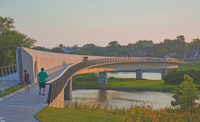Tolleson, Ariz.
Key Players
Owner/Developer City of Tolleson
Lead design Firm J2 Engineering & Environmental Design
General Contractor Valley Rain Construction Corp.
Subcontractors Kimbrell Electric, Roadsafe, Hunter Contracting, EPS Group, Makpro Services, Magsam Masonry, European Pavers Southwest, Northbay Tile, Creative Paving Solutions, Micon Construction, ACS Services, E2 Innovations, Sunland Asphalt, Sunline Contracting, Bart T Equipment, Dougherty Painting, Holiday Lighting, Performance Paving, American Asphalt, International Tension Structures, Dickens Quality Demolition, Ken’s Sign Service, Landscape Forms, Mood Media, CS&S Computers, Pavestone, Kornegay Design
A $9.3-million project has transformed Tolleson’s downtown area into a mile-long pedestrian-friendly destination now rebranded as the Paseo de Luces, or “path of lights.”
Prior to this project, the area consisted of a five-lane highway with narrow sidewalks. The project reduced vehicular lanes to three and added a colored median with aesthetic block patterns, bike lanes, on-street parallel parking and 15- to 28-ft-wide pedestrian zones.
Soon after the project began, an unscheduled upgrade to the gas infrastructure threatened to derail the schedule. Instead of accepting a two-month project delay, Valley Rain re-phased the project to allow for simultaneous construction of the new 8-in. gas line with new storm drain construction.
Well into construction, the team discovered that the existing clay subgrade below the newly removed concrete highway had retained excessive deep moisture and lacked the required stability to install new pavement.
The construction team used a polypropylene-woven geotextile-reinforcing fabric to stabilize the subgrade and prevent future problems. Because the fabric also added structural value to the roadway section, the thickness of the base course could be reduced, partially offsetting the cost of the reinforcing material.
“The fabric was manually rolled onto the subgrade in 15-inch overlapping widths. An 8-inch base course was then spread by dozers without contact of track or tire to the fabric,” says Daniel K. Kuwitzky, vice president of Valley Rain Construction.
Valley Rain self-performed many aesthetic portions of the project in order to maintain a higher degree of quality control, including adjusting bond dimensions of the decorative pavers to avoid shallow angles, cuts and slivers. Each concrete paver had a nominal width of 4 in., but actually measured slightly less due to the manufacturing process. The construction team field measured up to 20 courses to determine the exact variance to 0.01-in. accuracy and field-adjusted the surrounding concrete bands to align the joints.
“The pavers were placed on a 6-inch slurry base covered by a thin layer of leveling sand. They were then tightly set and vibrated into place, achieving a smooth, durable and highly aesthetic surface,” Kuwitzky says.
The construction team also focused on pedestrian and vehicular safety, since local residents had typically crossed at random locations before construction began.
“The challenge was to funnel the pedestrians into controlled crossings by use of movable pedestrian railings to prevent them from wandering into heavy equipment construction zones. Additional spotters on the ground aided in maintaining safe work zones,” Kuwitzky says.





Post a comment to this article
Report Abusive Comment